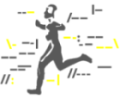





Search | Sitemap | Navigation |  |
|
||||||||||||||||||||||||||
|
||||||||||||||||||||||||||
|
||||||||||||||||||||||||||
|
| Body image disturbances |
Somatosensory symptoms
Somatosensory migraine aura symptoms are fully reversible sensory symptoms including positive features (i.e., pins and needles) and/or negative features (i.e., numbness).
Unilateral sensory symptoms are a characteristic feature of typical aura with migraine headache, whereas simultaneously bilateral paraesthesias occur in basilar-type migraine.

Visual aura with scintillating scotoma (above) and somatosensory aura with digitolingual syndrome (below) from left to right in their successive stages of development. Reproduced from Egilius L.H. Spierings, Management of Migraine, 1996. © 2005 Egilius L.H. Spierings
A typical presentation of the somatosensory aura is the digitolingual syndrome, as shown in the illustration reproduced by courtesy of Egilius L.H. Spierings. "In consists of a feeling of numbness and tingling that starts in the fingers of one hand", he wrote in his 1996 monograph Management of Migraine. "Subsequently, the numbness gradually extends upwards into the arm and, at a certain point, also involves the nose-mouth area on the same side. The progression of the numbness, like that of the scintillating scotoma, is slow and usually takes from 10 to 30 minutes." (Spierings, 1996, p. 8)
An example for a typical aura consisting of blindness and numbess affecting one half of the body, i.e. hemihypaesthesia: "I have had migraines since I was 11, and over the years I've gotten pretty damn good at recognizing warning signals... I get an aura (blindness) for half an hour, then after I get numbness on half of my body. (really freaky sometimes) It seems that you can draw a line down my body and half of my lips, tongue, face etc to one side goes tingly and numb. And then comes the pain."
(audrey kerves , Newsgroups: alt.support.headaches.migraine, Subject: Aura's and Warning Signals????, December 3, 1997)
References
Spierings ELH. Management of Migraine. Butterworth-Heinemann, Boston-Oxford-Melbourne-Singapore-Toronto-Munich-New Delhi-Tokyo 1996.
Author: Klaus Podoll
Last modification of this page: Tuesday March 29. 2005
| Body image disturbances |
 Top of the page
Top of the page| · | News |
| · | Medical Professionals |
| · | Medical Studies |
Copyright © 2005 Migraine Aura Foundation, All rights reserved. Last modification of this site: August 25, 2006
Thanks to: RAFFELT MEDIENDESIGN and GNU software | webmaster@migraine-aura.org
http://migraine-aura.org/EN/Somatosensory_Symptoms.html


